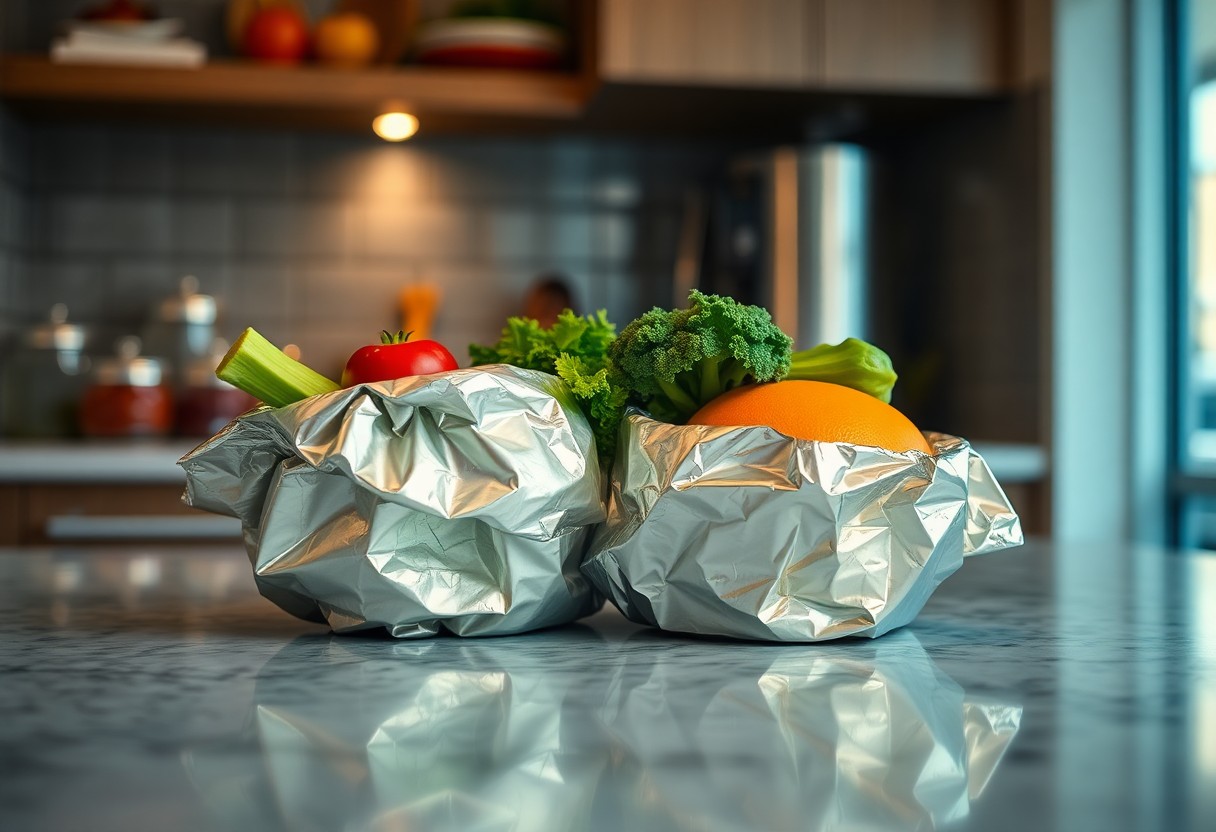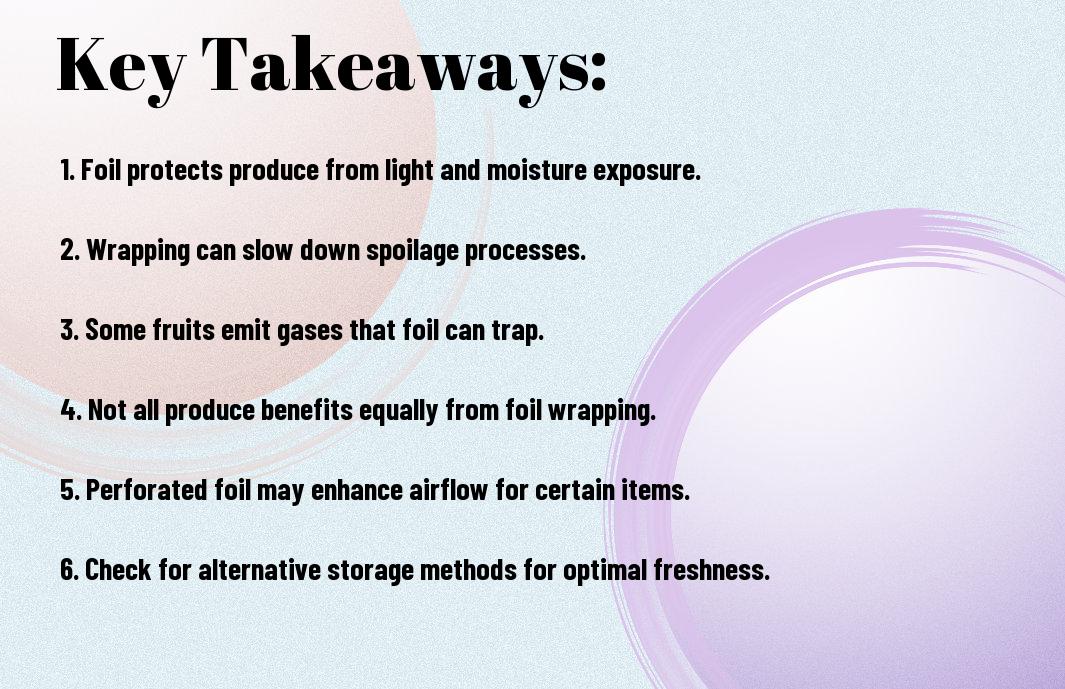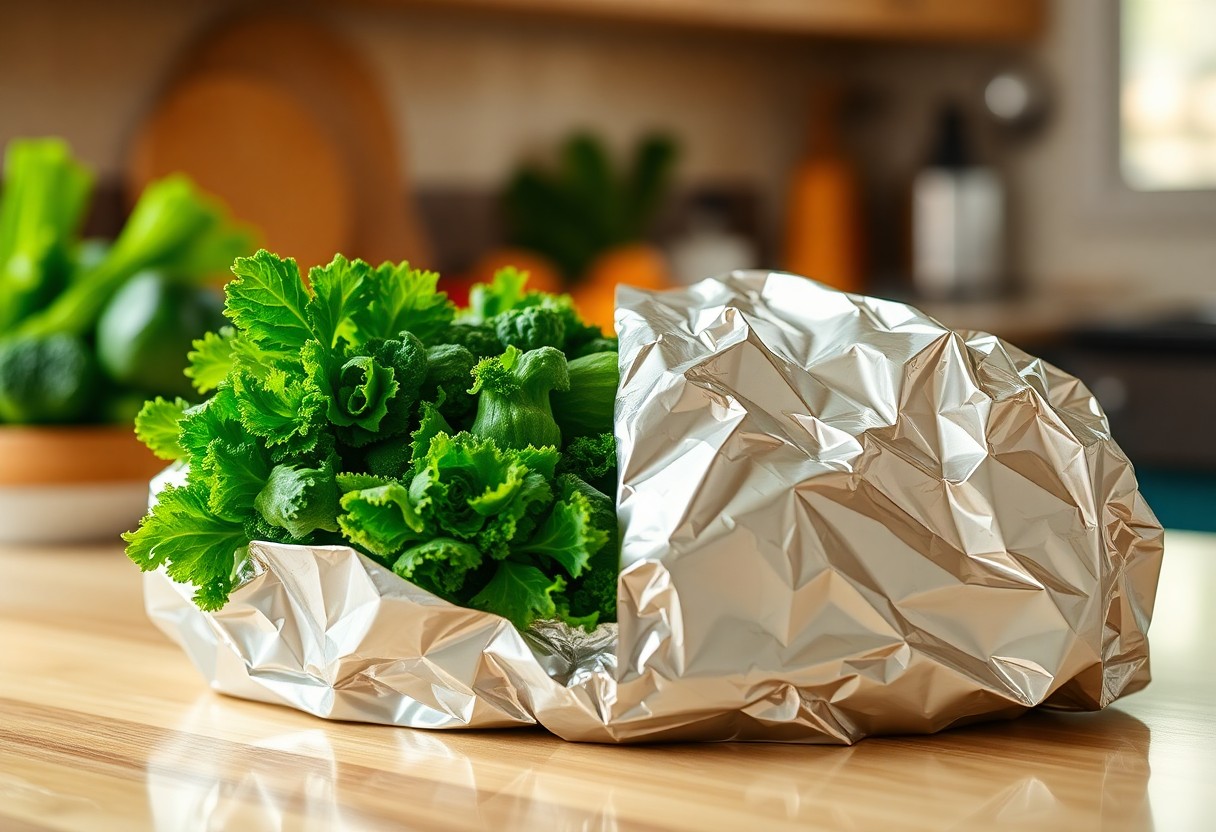Many people wonder whether wrapping produce in foil truly helps to maintain its freshness. While some fruits and vegetables may benefit from being wrapped, this practice can also trap moisture, leading to spoilage instead of preservation. To determine if foil is the right choice for your produce, you need to consider the type of food you are storing. In this post, you will discover the facts and myths surrounding the use of aluminum foil for keeping your produce fresh, helping you make informed decisions for your kitchen.

Key Takeaways:
- Wrapping produce in foil can help retain moisture and prevent spoilage for certain items, but it may not be the best option for all types of fruits and vegetables.
- Foil is not breathable, which can lead to increased condensation and potentially accelerate decay in produce that requires air circulation.
- For optimal freshness, consider using breathable alternatives like paper bags or mesh produce bags, which help maintain the right humidity levels and air flow.

The Science Behind Food Preservation
Before exploring into the methods of food preservation, it’s necessary to understand the science that underlies why certain materials can help keep your produce fresh. Food freshness relies on minimizing exposure to oxygen, moisture, and light, all of which can lead to spoilage. Various materials interact differently with these elements, affecting how long your fruits and vegetables can stay vibrant and delicious.
How Aluminum Foil Works
On the surface, aluminum foil appears to be a simple wrapping material, but it plays a significant role in food preservation. Its reflective surface blocks light, which can degrade produce quality. Additionally, aluminum foil acts as a barrier against air and moisture, preventing oxidation and dehydration, making it an effective choice for extending the lifespan of your food.
Comparison with Other Wrapping Materials
Between the various food-wrapping options available, understanding their effectiveness can significantly impact how you store your produce. Here’s a comparison of aluminum foil against other common wrapping materials:
Wrapping Material Comparison| Material | Effectiveness |
| Aluminum Foil | Excellent barrier against light, air, and moisture |
| Plastic Wrap | Good barrier, but not as effective against light |
| Wax Paper | Moderate barrier; allows some airflow |
| Beeswax Wraps | Eco-friendly, but not airtight |
Materials can significantly impact how well your produce stays fresh, with aluminum foil often being the top choice for blocking light and moisture. Meanwhile, plastic wrap provides *decent* protection but may not shield against light as effectively. Wax paper allows for some airflow, which is *not ideal* for moisture-sensitive goods, while beeswax wraps offer an eco-friendly option but may lack airtight properties. By selecting the right materials, you can ensure your fruits and vegetables remain as fresh as possible for longer periods.
Factors Affecting Freshness
Assuming you want to keep your produce fresh, several factors play a role in determining its longevity. These include:
- Type of produce
- Storage conditions
- Moisture levels
- Temperature
Knowing how these factors interact can help you make informed choices about storing your fruits and vegetables.
Type of Produce
After you choose the right type of produce, it’s crucial to know that different fruits and vegetables have unique freshness requirements. For example, leafy greens tend to wilt quickly, while root vegetables can last longer. By understanding the specific needs of each type, you can maximize their freshness and flavor.
Storage Conditions
Among the most significant aspects of maintaining freshness is the storage conditions for your produce. Keeping fruits and vegetables at the right temperature and humidity can make a substantial difference. Stores often recommend a cool, dark, and dry space, but specific produce might need refrigeration. For instance, high humidity can lead to mold growth, whereas excessive dryness can result in dehydration. Each produce type may have specific storage preferences that you should follow for longevity.
The right storage conditions are crucial for keeping your produce fresh and safe to eat. For example, fruits like apples and bananas emit ethylene gas, which can accelerate spoilage in nearby vegetables. Likewise, high moisture levels can promote bacterial growth, while low humidity can cause shriveling. Positioning your produce away from direct sunlight and ensuring adequate airflow can greatly enhance freshness and prevent spoilage.

Common Myths About Foil Wrapping
Keep in mind that many people believe foil wrapping is the ultimate solution for preserving the freshness of their produce. However, this belief often leads to misconceptions about the effectiveness of aluminum foil in preventing spoilage. While it may provide a barrier against some external elements, it isn’t a miracle preservation tool. Understanding the limitations of foil wrapping will help you make more informed choices about how to store your food.
Debunking Popular Beliefs
With numerous claims surrounding the benefits of foil wrapping, it’s important to separate fact from fiction. Many believe that wrapping fruits and vegetables in foil can extend their shelf life significantly, but this isn’t entirely accurate. Foil does not protect against moisture loss or gas exchange, which are key factors in the spoilage process. Using proper storage techniques tailored to each type of produce will yield much better results.
Misconceptions Surrounding Other Materials
Popular alternatives like plastic wrap and paper bags are often mistakenly assumed to be just as effective as foil for keeping produce fresh. While these materials do have their own advantages, they each come with unique limitations that you should be aware of. For instance, using plastic wrap can trap moisture, leading to mold growth, while paper bags can be less effective in humid environments.
Even if you choose to use other materials, it’s important to distinguish between them and know their strengths and weaknesses. For example, a plastic wrap can help seal in moisture but can also create a damp environment that encourages decay. On the other hand, a paper bag works well for some fruits but is inadequate for others prone to drying out. When you know the specific properties of each material, you can select the best option for your produce, ensuring its optimal freshness and longevity.
Practical Tips for Using Foil
All you need to do is follow these simple tips to enhance your food preservation technique with foil.
- Use heavy-duty foil for long-term storage.
- Ensure a tight seal around produce to prevent air exposure.
- Avoid using foil for items with high acidity, which can react.
- Label your wrapped items with the date for better tracking.
Thou should take these steps to enjoy fresher produce longer.
Best Practices for Wrapping
After selecting your foil, ensure you are wrapping the produce correctly by folding tightly and sealing the edges. This technique will keep the moisture in and air out, extending the freshness of your fruits and vegetables.
Avoiding Common Mistakes
Before you wrap your food, be mindful of common pitfalls that can reduce effectiveness.
Tips to avoid mistakes include ensuring that the surface of your produce is dry before wrapping to prevent mold growth, and using foil that is not too thin, as it can tear easily. Be wary of storing highly acidic foods like tomatoes or citrus in foil, as they may leach metallic flavors. Also, avoid placing wrapped items directly in the freezer, as condensation can form and compromise your food quality.
Expert Opinions and Studies
Now, numerous experts have weighed in on the effectiveness of foil in preserving the freshness of produce. While some suggest it can help keep fruits and vegetables from drying out, others warn about potential issues like moisture buildup. Understanding these perspectives can help you make informed choices about how best to store your food and reduce waste.
What Research Says
Before stepping into recommendations, it’s vital to examine the research surrounding the use of aluminum foil for produce. Various studies indicate that, while foil can reduce exposure to air and light, it may not be the ideal option for preventing spoilage in certain fruits and vegetables due to moisture retention issues.
Insights from Culinary Experts
At the same time, culinary experts provide valuable insights into the practical use of foil in food storage. Many chefs advocate for using aluminum foil to wrap certain items, emphasizing that it can be a useful tool for keeping your produce fresh when used correctly.
But some chefs caution against universally applying this method. They highlight that while foil can help prevent bruising and moisture loss in specific items, it can also create a trap for moisture, leading to quicker spoilage for others, such as leafy greens. Instead, it’s often best to use breathable materials like wax paper or produce bags for some fruits and vegetables. Adapting your storage method based on your produce type is key for maximizing freshness and longevity.
To wrap up
Now that you understand the facts about wrapping produce in foil, you can make informed choices about how to keep your fruits and vegetables fresh. While foil can provide some benefits, such as reducing exposure to air and light, it’s not a universal solution. Explore alternatives like wax paper or reusable lids to find what works best for your specific produce needs. Ultimately, knowing how each option affects freshness will empower you to maintain the quality of your food longer.
FAQ
Q: Does wrapping produce in foil actually help it stay fresh longer?
A: Wrapping produce in foil can help retain some moisture, which may keep certain fruits and vegetables fresh for a shorter period. However, it can also trap moisture leading to mold growth. The effectiveness varies based on the type of produce—leafy greens, for instance, may fare better when stored in breathable bags rather than foil.
Q: Are there specific types of produce that benefit from being wrapped in foil?
A: Yes, some produce like apples and bananas may benefit from being wrapped in foil as it helps keep their moisture content stable. However, for sensitive produce such as mushrooms or berries, it’s advisable to avoid foil to prevent excess moisture accumulation.
Q: Is it a good idea to wrap produce in foil before placing it in the refrigerator?
A: While foil can be used to wrap some produce before refrigeration, it is not universally recommended. Many fruits and vegetables are better stored in ventilated containers or bags that allow for airflow. This helps reduce moisture build-up and potential spoilage.
Q: What are some alternatives to foil for keeping produce fresh?
A: Alternatives to foil include plastic wrap, wax paper, or breathable produce bags. These materials can help keep moisture balanced while allowing for some airflow, which is necessary for many types of fruits and vegetables to prolong freshness.
Q: Can wrapping produce in foil affect its taste or texture over time?
A: Yes, wrapping in foil can affect taste and texture. If produce is wrapped too tightly or remains in foil for an extended period, it may become soggy or develop off-flavors. It’s best to assess the right wrapping technique based on the specific produce type and how soon you plan to consume it.
